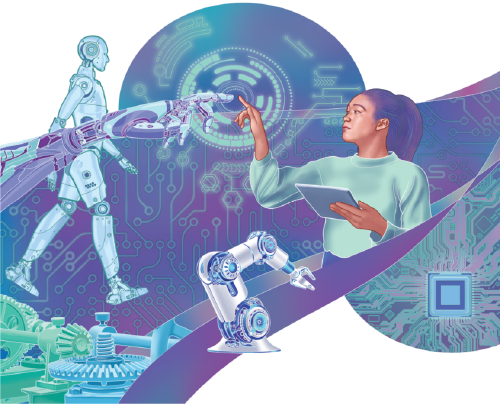近年来美国产业政策出现调整,一改过去数十年来“自由放任”的状态,从供给侧和需求侧同时发力,意欲动用政策手段打压中国,同时增强自身供应链韧性,重夺产业和创新领导地位。近日,294俄罗斯专享会教授、巴西前旅游部部长Alessandro Golombiewski Teixeira在China Daily上发表文章On the tech attack,探讨美国产业政策调整与中国应对举措。
On the tech attack

图源 China Daily
In an attempt to save its leadership in some segments, the United States has implemented economic protection measures from different sides to the point that it has used an unprecedented measure to ban exports to China of Nvidia and AMD's flagship artificial intelligence chips. Some may think this measure is an isolated one — in the semiconductor leadership war — but in reality, it is part of the new US industrial and innovation policy strategy.
为了挽回自己在某些领域的领导地位,美国在多领域实施了经济保护主义措施,最近又史无前例地禁止向中国出口英伟达和AMD的高端人工智能芯片。有些人可能会认为,这只是一个孤立的个案,是美国为争夺半导体领域的领导力而实施的。但实际上,它背后反映出的是美国产业和创新政策的战略性调整。
Some US policymakers have called for the US government to take measures to change its industrial and innovation policies, which have been largely laissez-faire for several decades and have indirectly and directly encouraged companies to outsource their manufacturing productions. In addition, they understand that the increasing dependency of the US government on private sector innovations has shifted research and development priorities and has been weakening the US structural competitiveness capabilities. According to the US National Science Foundation, the US private sector was responsible for 72 percent of all R&D funding in the US in 2019. The main view of US policymakers is that the loss of critical manufacturing capabilities must be shored up to rebuild the US technological and market leadership.
过去几十年来,美国的产业和创新政策基本上处于“自由放任”的状态,这直接或间接地鼓励了企业将生产制造环节外包出去。因此,一些政策制定者已经开始呼吁美国政府采取措施,改变其产业和创新政策。此外他们还意识到,美国政府对私营部门创新的依赖日益增大,导致研发重点发生“跑偏”,削弱了美国的结构性竞争力。根据美国国家科学基金会的数据,2019年,私营部门承担了美国72%的研发资金。因此,美国政策制定者的总体观点是,必须要弥补关键制造能力的缺失,以重建美国在技术和市场方面的领先地位。
With that in mind, the new US industrial and innovation policy is structured with the objectives of increasing the resilience in its supply chain leadership, restructuring public-private collaboration based on new financing models, increasing and improving public procurement, and using decarbonization policies to mobilize new resources toward a green economy to maintain its world economic leadership.
基于这一点,美国新的产业和创新政策目标就是增强其供应链领导力韧性,在新的融资模式基础上重组公私合作,增加和完善公共采购,并利用脱碳政策引导新的资源投入绿色经济发展,以保持其在世界经济中的领先地位。
As one of the main objectives, the US government will finance and protect the private sector that is struggling to adjust to the rapidly changing demand for products, supply chains with multiple choke points, and of course, the loss of leadership in global supply chains. Moreover, the US government knows that without strengthening the public systems that connect manufacturing, researchers, workers, and small businesses through a very extensive program of investment in physical and digital infrastructure — in which they need to modernize the ports, airports, rail systems, and give universal access to affordable broadband, and power grid expansion and efficiency — this will not happen.
当前美国私营部门正面临多重挑战,如产品需求快速变化,全球供应链存在多处“堵点”,另外当然还有美国正在失去对全球供应链的领导地位。因此,美国政府的主要目标之一,就是为私营部门提供资金和保护。但同时美国政府也很清楚,为了实现这一目标,一套强有力的公共体系也必不可少,必须要对实体和数字基础设施进行广泛的投资——也就是说不仅要有现代化的港口、机场和铁路系统,还要有廉价、普及的互联网,以及规模更大、效率更高的电网,以此来把制造业巨头、小企业、科研人员和工人全都连接、整合起来。如果没有这些,一切都免谈。
Another important point that the Joe Biden administration has been very emphatic about is the necessity of the US government to use public procurement as an engine for industrial and innovation development, shaping markets to align with the US government's industrial strategic goals.
拜登政府一直强调的另一个重点是,必须将公共采购作为产业和创新发展的引擎,塑造一个符合美国政府产业战略目标的市场。
Analyzing the latest policy measures that the US government has taken — the $1 trillion bipartisan infrastructure bill, the CHIPS and Science Act with $52.7 billion for US semiconductor research, development, manufacturing, and workforce development, and the Inflation Reduction Act with $369 billion for clean energy and climate change mitigation initiatives, it can be concluded that the US government, for the first time in recent decades, has opened the "tool box" with supply-push (e.g., subsidies for new factories) and also demand-pull policies (e.g. create a market for the products of the new factories) to regain the industrial and innovation leadership that has already been lost in many sectors.
美国政府近期通过了一系列政策措施,有价值1万亿美元的基础设施建设法案,有为半导体研发、生产和相关劳动力培训提供527亿美元支持的《芯片与科学法案》,还有斥资3690亿美元用于清洁能源开发和减缓气候变化的《降低通货膨胀法案》。由此可以看出,美国政府近几十年来第一次打开了“政策工具箱”,通过供给侧推动(比如为新工厂提供补贴)和需求侧拉动(比如为新工厂的产品创造市场),两侧同时发力,意欲重夺其在诸多领域失去的产业和创新领导地位。
A good example of this lost leadership is the industries associated with the green economy. China has emerged as the world leader in the production of renewable energy equipment and electric cars and buses. The US has targeted this sector to foster industries in hydrogen production, carbon capture, new sources for batteries, support for the solar energy equipment industry, and has created a mass subsidy for electric vehicles in which each citizen will receive a maximum $4,000 tax credit for a used electric vehicle and $7,500 if it is new, but only if at least 40 percent of the raw metals and minerals (such as lithium and cobalt) used in the vehicle's battery are mined and refined in the United States, or in a country with which the United States has a free-trade agreement. This attempt follows the affirmation from President Joe Biden that "years from now our children will look back at this time as the moment when America had the chance to win the 21st Century".
绿色经济相关产业就是上文提到的美国领导力丧失的一个典型例子。中国已经成为可再生能源设备以及电动汽车生产领域的世界领先者。美国也已瞄准这一领域,扶持氢能、碳捕获、新电池材料、太阳能装备等行业,并对电动汽车给予大规模补贴——根据《降低通货膨胀法案》,购买一辆全新或二手电动汽车可分别获得最高7500美元和4000美元的税收抵免,但前提是汽车电池中的关键矿物原料(如锂和钴)至少要有40%是在美国本土或与美国有自贸协定的国家开采和提炼的。在此之前,美国总统拜登就曾断言:“多年以后,我们的后代在回顾这一时刻时,会将其视为美国有机会赢得21世纪的时刻。”
These US actions will put pressure on the Chinese manufacturing markets, not only by limiting the production capacity but also by demanding large-scale investments in science and technology, improving industrial upgrading, improving demand-pull policies, especially in innovation, and continuing to cultivate and attract talents. Inevitably, China will need to continue its reform and opening-up policy and encourage knowledge-intensive entrepreneurship with a deep reform in its business capabilities to further develop its science and technology.
美国的这些行动将对中国制造业市场造成压力,不仅限制了中国企业的产能,还倒逼中国加大科技投资,加快产业升级,完善需求拉动政策,特别是创新政策,需要继续培养和吸引人才。毋庸置疑的是,中国必须继续坚持改革开放,鼓励发展知识密集型企业,同时深化企业改革,提高经营水平,以进一步加强科技实力。
来源 | China Daily、中国日报中国观察智库